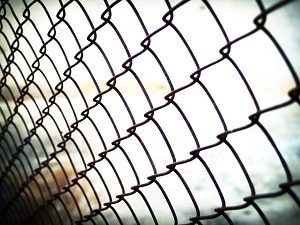How Much Does a Chain Link Fence Cost?
Last Updated on March 14, 2024
Written by CPA Alec Pow | Content Reviewed by ![]() CFA Alexander Popinker
CFA Alexander Popinker
Many homeowners are interested in installing a chain link fence around their property. This guide explains everything that impacts chain link fencing costs. You’ll also find tips to save money on installation.
How Much Does a Chain Link Fence Cost?
Installing a chain link fence around your property typically costs between $1,200 and $4,000. Most homeowners can expect to pay about $2,100. The final price depends quite a bit on the height and style you choose, as well as the length needed to surround your yard.
According to HomeGuide, the cost of a 150′ chain-link fence installation ranges from $1,350 to $3,900 on average. The material prices are $4 to $15 per foot, with additional costs for installation.
A Better Fence Construction notes that the pricing for chain-link fences is calculated per linear foot and varies based on factors such as the height of the fence, galvanized or vinyl coated, and the price of the fence materials. The cost ranges around $12-19 per foot installed, depending on the height of the fence and the type of material.
According to Brian Gregory at Foothill Fence, standard galvanized chain-link fencing costs about $10 per linear foot, and vinyl-coated chain-link fencing costs about $14 per linear foot.
Forbes writes in an article that chain link fences usually cost between $1,200 and $4,000 to install, with most homeowners paying around $2,100. The installation costs are affected by factors such as the fence’s height, finish, and the length of the fence line.
What Goes Into the Cost?
Several factors account for cost differences between chain link fence projects. The height, wire gauge/thickness, and coating finish can change what you’ll pay per linear foot. Extras like landscaping, excavation, gates, and privacy slats also affect the final price.
Calculating Your Chain Link Fence Cost
Figuring out how much you’ll pay starts with:
Measuring Length – Mark out and measure the perimeter length needed in linear feet.
Choosing Height – Decide on a height between 3 and 12 feet tall that fits your needs.
Selecting Materials – Pick a chain link metal finish like powder-coated, galvanized, vinyl-coated, or bare wire. Each comes at different price points per linear foot.
Then look up your area’s cost range for the finish you want. Multiply this by the total fencing area needed. This provides an initial budget estimate.
Refine this number by adding:
- Metal or wood fence posts every 8-10 feet
- Walkway and/or driveway gates
- Post caps or hardware
- Local permit fees if required
- Installation labor charges
Chain-Link Fence Cost Factors Breakdown
Chain link fence costs generally depend on:
Height
Higher fences require more materials. With professional installation, prices per linear foot typically are:
| Height of Fence | Cost Range (USD) |
|---|---|
| 4 feet | $8 to $20 |
| 5 feet | $9 to $22 |
| 6 feet | $10 to $29 |
| 8 feet | $12 to $34 |
| 10 feet | $17 to $40 |
Wire Gauge/Thickness
Thinner gauge wire is cheaper but less durable:
| Gauge (Thickness) | Cost Range (USD per linear foot) | Type of fence |
|---|---|---|
| 6 gauge | $4 to $20 | Most heavy duty |
| 9 gauge | $2 to $10 | Standard residential |
| 11.5 gauge | $1.50 to $7 | Less durable |
Coating/Finish Options
Common chain link fence finish options include:
| Coating/Finish Type | Cost Range (USD per linear foot) | Description |
|---|---|---|
| Galvanized | $5 to $15 | Withstands weather |
| Powder-coated | $6 to $8 | Resists corrosion |
| Vinyl-coated | $10 to $30 | Variety of colors |
| Bare metal | $1.50 to $6 | Prone to rust |
Property Size
On larger properties, average costs for a 4-foot fence are:
- 1/4 acre – About $3,100
- 1/2 acre – About $4,400
- 1 acre – About $8,000
What About Installation?
For pro installation, you’ll generally pay $5 to $25 per linear foot in labor fees. DIY can cut this cost in half but requires more tools/time.
What Other Factors Impact Cost?
Some other considerations that affect chain link fence total cost:
- Diamond hole size – Smaller holes add durability/security
- Post material – Wood vs metal
- Gate type and size – Walkway, driveway, materials
- Local permit requirements
- Privacy slats add expense
The Fence Installation Process
Typical chain link fence installation steps include:
- Measure/mark out perimeter
- Dig holes for posts
- Set posts in concrete
- Attach top rails between posts
- Hang mesh and stretch tightly
- Attach mesh to posts/rails
- Hang gates and finishing touches
DIY vs Hiring a Professional
If you hire a pro, expect to pay $5-$25 per linear foot in labor costs to install your chain link fence. Doing it yourself can cut the installation cost in half, saving you quite a bit of money. However, DIY does require purchasing or renting more equipment like an auger, pipe cutters, and fence stretchers.
You might also like our articles about the cost of a wooden split rail fence, a wood or timber retaining wall, or block foundation repair work.
You’ll also need about 25 hours for the project unless you have assistance. Consider whether you realistically have enough time and energy before deciding to tackle a DIY fence install. Carefully weigh the cost savings against the tool and time demands.
Questions for Your Contractor
If hiring a pro, ask these questions before choosing someone:
- Are you properly licensed and insured?
- How many chain link installs have you done?
- What is your payment schedule?
- How will we communicate during the project?
- Can you provide references?
- Do you offer a workmanship warranty?
- How will you confirm compliance with codes?
- How long will the installation take?
Getting Cost Estimates
To estimate the figures in this article, we checked pricing from five national and local cost databases. The averaged prices were current at time of writing but may change over time.
Expanding on Additional Costs
A few other expenses can come up:
Painting or Finishing
 If you don’t choose a powder-coated finish, you might choose to paint it later using exterior-grade primer and paint. Doing it yourself costs $50-$100 for supplies. Hiring a pro runs $5-$8 per linear foot.
If you don’t choose a powder-coated finish, you might choose to paint it later using exterior-grade primer and paint. Doing it yourself costs $50-$100 for supplies. Hiring a pro runs $5-$8 per linear foot.
Old Fence Removal
Taking out an old fence first often makes sense. This typically costs $3-$5 per linear foot. In some cases, you may be able to salvage and reuse or sell the old materials.
Grading and Excavation
If installing on uneven ground, you’ll probably need grading and excavation. Figure $5-$10 per square foot for this service.
Land Surveying
Before installing, it’s very important to precisely map your property lines and landscape where the fence will go. Land survey fees generally range from $300 to $2,000, with $500 being a typical cost.
Landscaping and Clearing
Do any required landscape clearing or tree removal along the fence line first. This usually costs $2-$5 per square foot. Taking out mature trees can add $750-$1,000 each.
Saving on Installation
You might be able to save money by:
- Getting multiple installation quotes
- Handling parts of the job yourself
- Choosing the shortest workable fence height
- Skipping fancy extras
- Using recycled materials when possible
- Picking more affordable finishes


Leave a Reply
Want to join the discussion?Feel free to contribute!